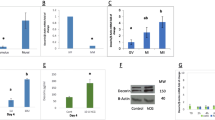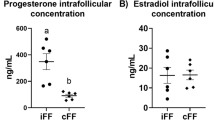Abstract
Based on a previous global transcriptome sequencing project, we hypothesized that Lumican (LUM) might play a role in ovulatory processes. We sought to determine LUM gene expression under various conditions in human preovulatory follicles. The in vitro expression of LUM mRNA in mural (MGCs) and cumulus (CGCs) granulosa cells was characterized using quantitative real-time polymerase chain reaction (qRT-PCR). Immunohistochemical staining was used to identify human LUM expression in follicles at different developmental stages. Cell signaling studies were performed by treating human MGCs with human chorionic gonadotropin (hCG) and both, different stimulators and inhibitors to determine their effect on LUM expression by using qRT-PCR. Cell confluence studies were carried out to study the correlation between LUM expression and follicle cell proliferation. Follicular MGCs and CGCs of women undergoing in vitro fertilization (IVF) procedures due to endometriosis were analyzed for differences in LUM expression patterns by qRT-PCR. LUM mRNA expression was significantly higher in MGCs as compared to CGCs. In CGCs, LUM mRNA was higher in mature metaphase II (MII) oocytes than in germinal vesicle (GV) and metaphase I (MI) oocytes. LUM expression was significantly upregulated in response to hCG in cultured MGCs. Immunohistochemistry of human ovaries revealed LUM was mostly present in MGCs of large preovulatory and postovulatory follicles and absent from primordial follicles. Using pharmacological activators and inhibitors, we demonstrated that LUM induction by luteinizing hormone (LH)/hCG is carried through the mitogen-activated protein kinase (MEK) pathway. LUM expression was induced in high-density cell cultures in a confluence-dependent manner. MGCs from follicles of subjects with endometriosis exhibited reduced mRNA transcription levels compared to control subjects. Our study confirms that LUM is a newly discovered ovulatory gene. LUM might play an important role during the preovulatory period up until ovulation as well as in endometriosis infertility. A better understanding of LUM’s role might provide potential new treatment paradigms for some types of female infertility




Similar content being viewed by others
Data Availability
The data sets used and/or analyzed during the current study are available from the corresponding author on reasonable request
References
Chakravarti S, Paul J, Roberts L, Chervoneva I, Oldberg A, Birk DE. Ocular and scleral alterations in gene-targeted lumican-fibromodulin double-null mice. Invest Ophthalmol Vis Sci. 2003;44:2422–32.
Nikitovic D, Katonis P, Tsatsakis A, Karamanos NK, Tzanakakis GN. Lumican, a small leucine-rich proteoglycan. IUBMB Life. 2008;60:818–23.
Nikitovic D, Papoutsidakis A, Karamanos NK, Tzanakakis GN. Lumican affects tumor cell functions, tumor–ECM interactions, angiogenesis and inflammatory response. Matrix Biol. 2014;35:206–14.
Naito Z, Ishiwata T, Kurban G, Teduka K, Kawamoto Y, Kawahara K, et al. Expression and accumulation of lumican protein in uterine cervical cancer cells at the periphery of cancer nests. Int J Oncol. 2002;20:943–8.
Radwanska A, Litwin M, Nowak D, Baczynska D, Wegrowski Y, Maquart F-X, et al. Overexpression of lumican affects the migration of human colon cancer cells through up-regulation of gelsolin and filamentous actin reorganization. Exp Cell Res. 2012;318:2312–23.
Kang Y, Roife D, Lee Y, Lv H, Suzuki R, Ling J, et al. Transforming growth factor-β limits secretion of lumican by activated stellate cells within primary pancreatic adenocarcinoma tumors. Clin Cancer Res. 2016;22:4934–46.
Chakravarti S, Stallings RL, SundarRaj N, Cornuet PK, Hassell JR. Primary structure of human lumican (keratan sulfate proteoglycan) and localization of the gene (LUM) to chromosome 12q21.3-q22. Genomics. 1995;27:481–8.
Kao WW-Y, Funderburgh JL, Xia Y, Liu C-Y, Conrad GW. Focus on molecules: lumican. Exp Eye Res. 2006;82:3–4.
Deere M, Dieguez JL, Yoon S-JK, Hewett-Emmett D, de la Chapelle A, Hecht JT. Genomic characterization of human DSPG3. Genome Res. 1999;9:449–56.
Grover J, Chen X-N, Korenberg JR, Roughley PJ. The human lumican gene organization, chromosomal location, and expression in articular cartilage. J Biol Chem American Society for Biochemistry and Molecular Biology. 1995;270:21942–9.
Kedem A, Ulanenko-Shenkar K, Yung Y, Yerushalmi GM, Maman E, Hourvitz A. elucidating decorin’s role in the preovulatory follicle. J Ovarian Res [Internet]. 2020 [cited 2020 Jul 21];13. Available from: https://www.ncbi.nlm.nih.gov/pmc/articles/PMC7011259/
Mamo S, Carter F, Lonergan P, Leal CL, Al Naib A, McGettigan P, et al. Sequential analysis of global gene expression profiles in immature and in vitro matured bovine oocytes: potential molecular markers of oocyte maturation. BMC Genomics. 2011;12:151.
Bunel A, Jorssen EP, Merckx E, Leroy JL, Bols PE, Sirard MA. Individual bovine in vitro embryo production and cumulus cell transcriptomic analysis to distinguish cumulus-oocyte complexes with high or low developmental potential. Theriogenology. 2015;83:228–37.
Yoo SW, Savchev S, Sergott L, Rezai T, Lopez MF, Von Wald T, et al. A large network of interconnected signaling pathways in human ovarian follicles is supported by the gene expression activity of the granulosa cells. Reprod Sci. 2011;18:476–84.
Vlahos CJ, Matter WF, Hui KY, Brown RF. A specific inhibitor of phosphatidylinositol 3-kinase, 2-(4-morpholinyl)-8-phenyl-4H-1-benzopyran-4-one (LY294002). J Biol Chem. 1994;269:5241–8.
Duncia JV, Santella JB, Higley CA, Pitts WJ, Wityak J, Frietze WE, et al. MEK inhibitors: the chemistry and biological activity of U0126, its analogs, and cyclization products. Bioorg Med Chem Lett. 1998;8:2839–44.
Papoutsidakis A, Giatagana EM, Berdiaki A, Spyridaki I, Spandidos DA, Tsatsakis A, et al. Lumican mediates HTB94 chondrosarcoma cell growth via an IGF-IR/Erk1/2 axis. Int J Oncol. 2020;57:791–803.
Vij N, Roberts L, Joyce S, Chakravarti S. Lumican suppresses cell proliferation and aids Fas–Fas ligand mediated apoptosis: implications in the cornea. Exp Eye Res. 2004;78:957–71.
Ribatti D. A revisited concept: contact inhibition of growth. From cell biology to malignancy. Exp Cell Res. 2017;359:17–9.
Abercrombie M. Contact inhibition in tissue culture. In Vitro. 1970;6:128–42.
Assou S, Haouzi D, Mahmoud K, Aouacheria A, Guillemin Y, Pantesco V, et al. A non-invasive test for assessing embryo potential by gene expression profiles of human cumulus cells: a proof of concept study. Mol Hum Reprod. 2008;14:711–9.
McKenzie LJ, Pangas SA, Carson SA, Kovanci E, Cisneros P, Buster JE, et al. Human cumulus granulosa cell gene expression: a predictor of fertilization and embryo selection in women undergoing IVF. Hum Reprod. 2004;19:2869–74.
Maman E, Yung Y, Kedem A, Yerushalmi GM, Konopnicki S, Cohen B, et al. High expression of luteinizing hormone receptors messenger RNA by human cumulus granulosa cells is in correlation with decreased fertilization. Fertil Steril. 2012;97:592–8.
Yung Y. Localization of luteinizing hormone receptor protein in the human ovary. Mol Hum Reprod. 2014;20:844–9.
Breckwoldt M, Selvaraj N, Aharoni D, Barash A, Segal I, Insler V, et al. Expression of Ad4-BP/cytochrome P450 side chain cleavage enzyme and induction of cell death in long-term cultures of human granulosa cells. Mol Hum Reprod. 1996;2:391–400.
Ophir L, Yung Y, Maman E, Rubinstein N, Yerushalmi GM, Haas J, et al. Establishment and validation of a model for non-luteinized human mural granulosa cell culture. Mol Cell Endocrinol. 2014;384:165–74.
Yerushalmi GM. Characterization of the human cumulus cell transcriptome during final follicular maturation and ovulation. Mol Hum Reprod. 2014;20:719–35.
Smale ST. Selective transcription in response to an inflammatory stimulus. Cell. 2010;140:833–44.
Conti M. Specificity of the cyclic adenosine 3’,5’-monophosphate signal in granulosa cell function. Biol Reprod. 2002;67:1653–61.
Cameron MR, Foster JS, Bukovsky A, Wimalasena J. Activation of mitogen-activated protein kinases by gonadotropins and cyclic adenosine 5’-monophosphates in porcine granulosa cells. Biol Reprod. 1996;55:111–9.
Carvalho CR, Carvalheira JB, Lima MH, Zimmerman SF, Caperuto LC, Amanso A, et al. Novel signal transduction pathway for luteinizing hormone and its interaction with insulin: activation of Janus kinase/signal transducer and activator of transcription and phosphoinositol 3-kinase/Akt pathways. Endocrinology. 2003;144:638–47.
Morris JK, Richards JS. Luteinizing hormone induces prostaglandin endoperoxide synthase-2 and luteinization in vitro by A-kinase and C-kinase pathways. Endocrinology. 1995;136:1549–58.
Natraj U, Richards JS. Hormonal regulation, localization, and functional activity of the progesterone receptor in granulosa cells of rat preovulatory follicles. Endocrinology. 1993;133:761–9.
Woods DC, Johnson AL. Protein kinase C activity mediates LH-induced ErbB/Erk signaling in differentiated hen granulosa cells. Reproduction. 2007;133:733–41.
Seger R, Hanoch T, Rosenberg R, Dantes A, Merz WE, Strauss JF, et al. The ERK signaling cascade inhibits gonadotropin-stimulated steroidogenesis. J Biol Chem. 2017;292:8847.
Acknowledgements
We thank Daniela Kamir, Ph.D. (Bioforum Group), for her assistance in editing the manuscript.
Author information
Authors and Affiliations
Contributions
AK: analyzing and interpretation of the data, major contributor in writing the manuscript
USK: lab work, analyzing and interpretation of the data, contributor in writing the manuscript
YY: study design, lab work, data analyzing and interpretation, contributor in writing the manuscript
GY: data analyzing and interpretation, contributor in writing the manuscript
MY: data analyzing and interpretation
SA: data analyzing and interpretation
HA: conception and design, interpretation, contributor in writing the manuscript
Corresponding author
Ethics declarations
Ethics Approval and Consent to Participate
The study was approved by the local Institutional Review Board (IRB) committee of Chaim Sheba Medical Center, Tel Hashomer (ethical approval number SMC-17-4521). Written informed consent was obtained from each patient who provided samples. All experiments involving mice were conducted in compliance with the principles of the National Research Council (NRC) and were approved by the institutional animal care and use committee (IACUC) #919/14/ANIM.
Consent for publication
Not applicable
Competing Interests
The authors declare no competing interests.
Additional information
Publisher’s Note
Springer Nature remains neutral with regard to jurisdictional claims in published maps and institutional affiliations.
Rights and permissions
About this article
Cite this article
Kedem, A., Ulanenko-Shenkar, K., Yung, Y. et al. The Involvement of Lumican in Human Ovulatory Processes. Reprod. Sci. 29, 366–373 (2022). https://doi.org/10.1007/s43032-021-00650-y
Received:
Accepted:
Published:
Issue Date:
DOI: https://doi.org/10.1007/s43032-021-00650-y




